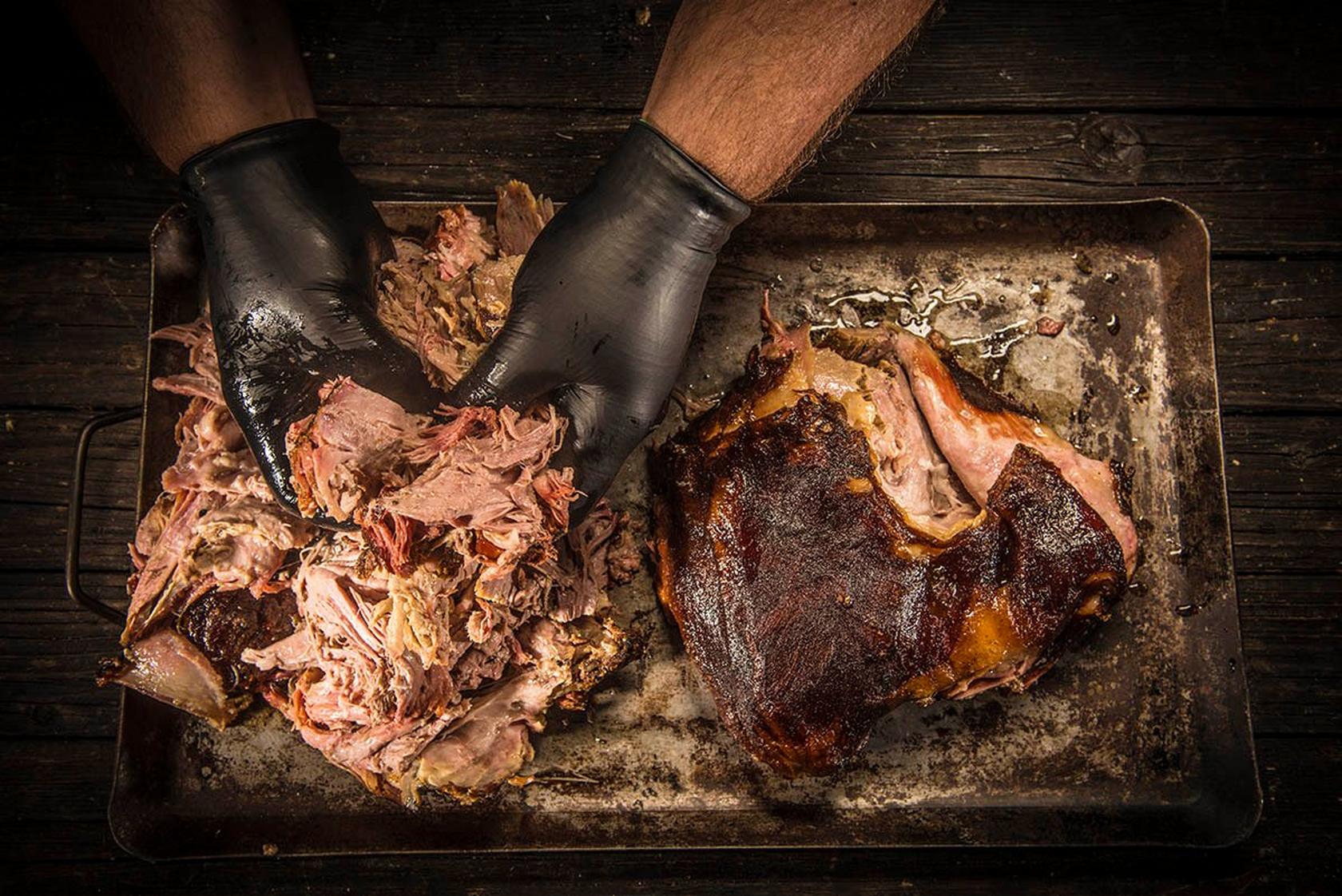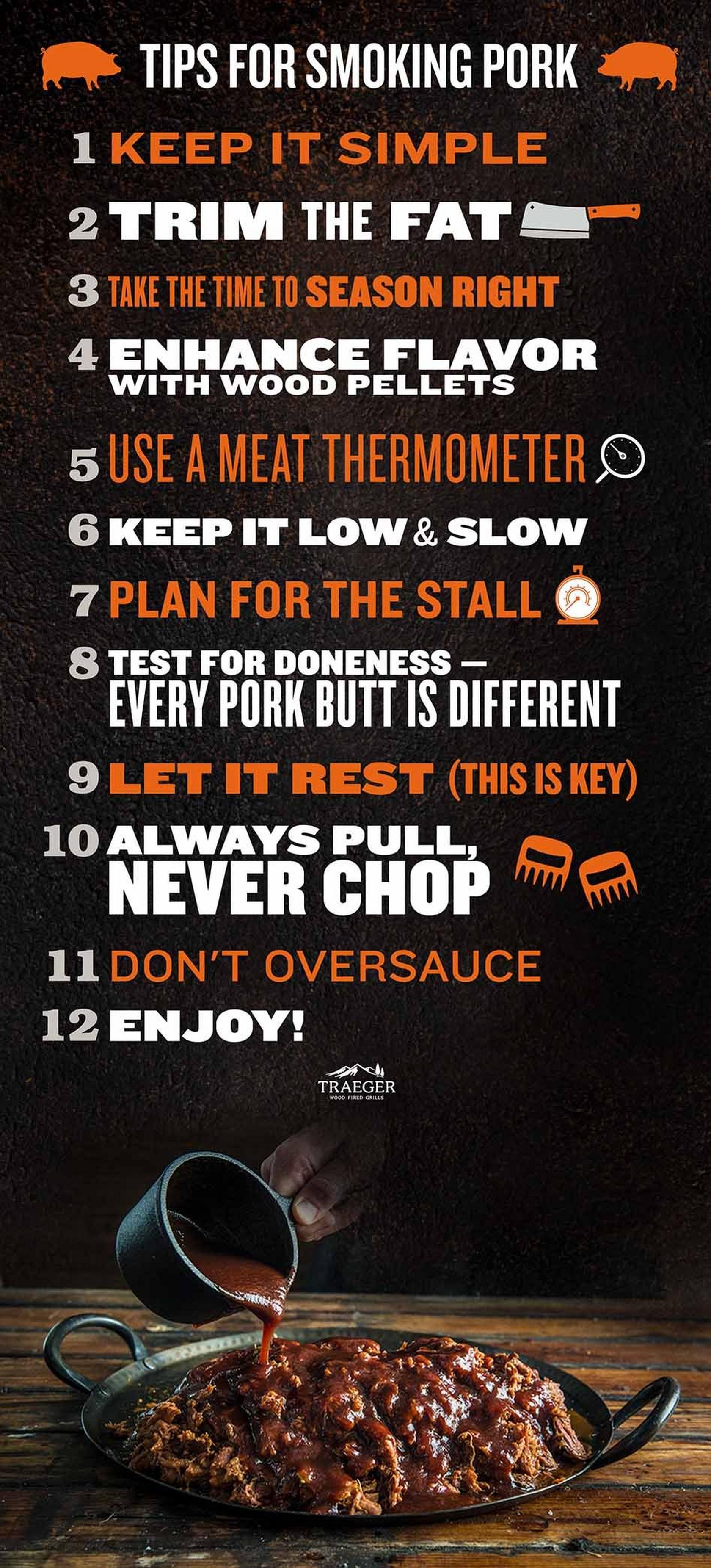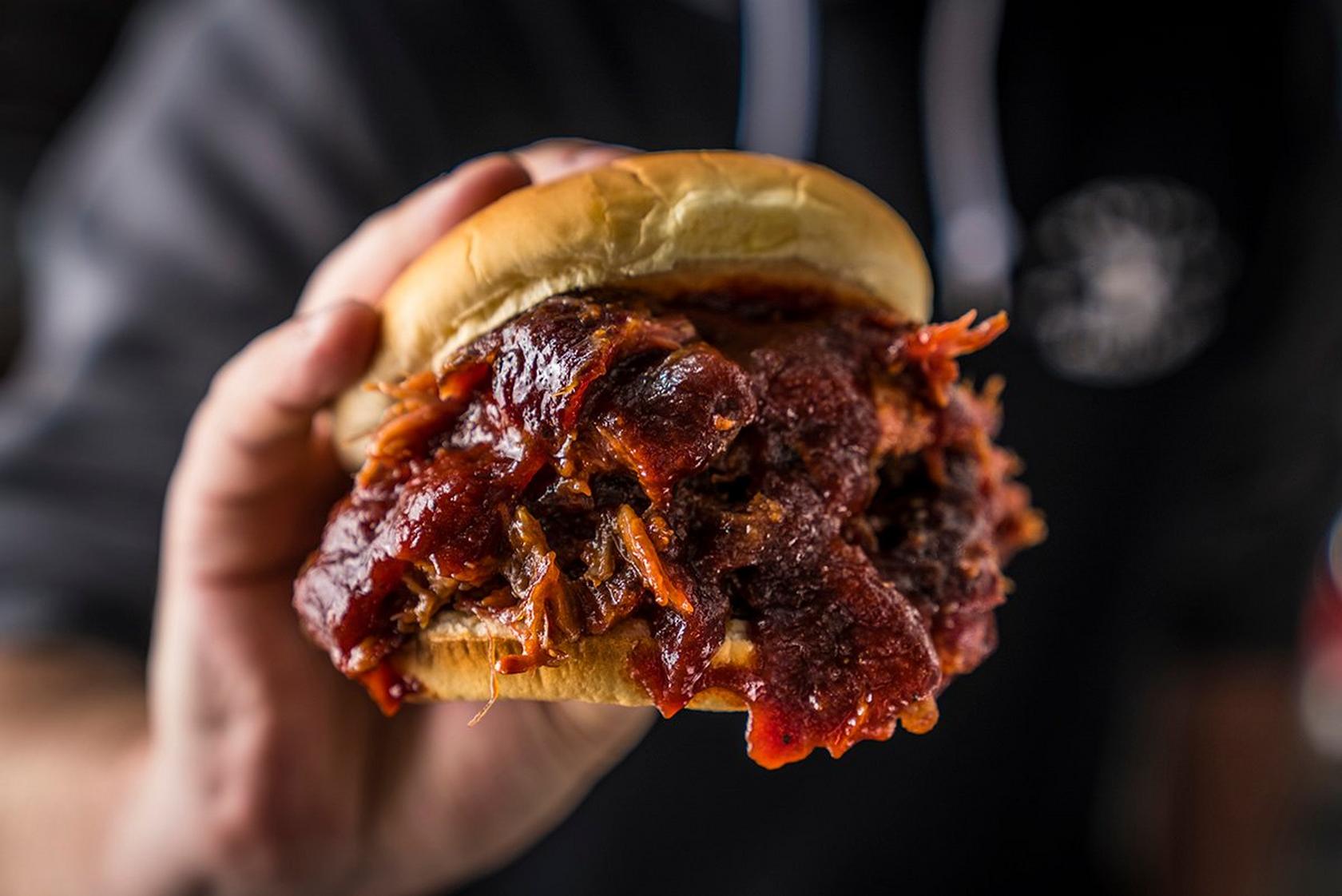How to Smoke Pork Butt for Pulled Pork

Pulled pork - the feast of champions.
How to Buy Pork Shoulder for Pulled Pork How Much Pork Do You Need? Tips for Smoking Pork How to Cook Pulled Pork on a Pellet Grill
How to Cook Pulled Pork in a Slow Cooker How to Cook Pulled Pork in the Oven Smoked Pulled Pork Leftovers
This beloved low-and-slow smoked meat is the perfect solution for feeding a large, hungry crowd. Pork shoulder is laced with flavorful fat and connective tissue that melt when cooked low and slow, giving the pork an incredibly tender texture and succulent flavor.
How to Buy Pork Shoulder for Pulled Pork
A full pork shoulder can weigh between 8 and 20 pounds and has two halves: the pork shoulder picnic ham.
Pork shoulder (also sometimes called "Boston butt") a well-marbled cut that comes from the top portion of a pig's front leg. It is sold with the bone-in (averaging 6-9 lbs.) or without the bone (averaging 5-8 lbs.).
A picnic ham (also sometimes called "picnic shoulder") comes from the lower part of the shoulder. A picnic ham usually has a thick layer of fat, which is good for making pork cracklins.
Which cut should you use? Our preferred cut is the pork shoulder (Boston Butt).
What about boneless vs. bone-in? When it comes to pulled pork, it’s actually easier to cook with the bone. Having a bone in the meat helps retain moisture and flavor.
How Much Pork Do You Need?
Plan on about one-half pound per person. Be aware that there is significant shrinkage and waste, due to the bone and fat you discard when pulling the pork. Count on approximately 30% loss.
Tips for Smoking Pork
Here are a few thoughts from expert pitmasters on how to make the best pulled pork on the block.

1) Keep It Simple
Skip any marinades, injections or brines. The purpose of marinades and brines is to tenderize, moisturize, and flavor the meat, so you don't want to overdo it. This cut of pork is flavorful enough that a good rub and the kiss of smoke, combined with the moisture provided by the internal fat and collagen, will make it taste wonderful.
2) Trim the Fat
Trim off most of the fat from the exterior of the meat but not all of it. Remember that you want the seasonings to hug the meat and get that crunchy, flavor-blasted bark.
3) Take the Time to Season Right
First, rinse and dry the meat. Then pat it dry, which will help the rub stick to the meat. Cover the meat thoroughly with your favorite seasoning. We suggest our Pork & Poultry Shake or Sweet Rub. Allow the seasoned meat to sit for at least an hour to allow the salt and spices to penetrate. Do not let it sit too long, or the rub may start to pull out moisture.
4) Enhance Flavor With Wood Pellets
The wood pellets you use for smoking the pork also enhance the flavor quite a bit. It’s hard to go wrong with using your favorite, but if you’re just getting into pellet grilling, a Signature Blend and Hickory will give your meat full-bodied flavor. For a sweeter touch, try Maple or Pecan BBQ Wood Pellets.
5) Use a Meat Thermometer
Pulled pork's best friend is a good meat thermometer. Carefully watching the temperature can make all the difference.
6) Keep It Low and Slow
Cooking temperature all depends on how much time you have to really work some love and smoke into that pork. If you have the time, 225 degrees Fahrenheit is an excellent sweet spot for low-and-slow cooked pork shoulder.
7) Plan for the Stall
The temperature of the pork rises steadily to 150 degrees Fahrenheit, and then hovers there for what feels like forever while the moisture moves to the surface and evaporates. It may hold that temperature between 150 and 160 degrees Fahrenheit for up to five hours. Be patient; don't crank up the heat just yet or open the lid. The big determining factor of the duration of the stall is the thickness of the meat.
8) Test for Doneness — Every Pork Butt Is Different
When is it ready? Depends on the size. The internal temperature needs to get to at least 195 degrees Fahrenheit, which will take 8-10 hours.
Once that happens, try these tests:
If you are cooking a bone-in pork butt, use a glove or paper towel to protect your fingers and wiggle the bone. It should easily turn and come out of the meat. This means she is done.
If you are smoking a boneless butt, insert a fork in the meat and try to rotate it. If it turns with only a little torque, your meat is done.
The color of your pork butt could be misleading. The exterior should look dark brown in color.
If the pork butt hasn't reached the desired internal temperature, or isn't tender, close the lid and let it cook for another 30 minutes before you check again.
If it is still not tender enough, you may have a tough butt. Try wrapping it in aluminum foil and let it go for another hour. However, do not take it above 205 degrees Fahrenheit or the muscle fibers will start giving up moisture and toughen.
9) Let It Rest (This Is Key)
When your pork is finally ready to come off the grill, take a quick taste. You should notice a thick flavorful crust, or "bark", and a "smoke ring" below the bark.
Let it rest for 30 to 60 minutes in a faux Cambro, in an oven at about 170 degrees Fahrenheit, or wrapped in foil. If you are more than an hour from mealtime, you can leave the meat on the Traeger with the heat off, or put it in the indoor oven and hold it there by dialing the temp down to about 170 degrees.
Make a faux Cambro using a tight plastic beer cooler. Leave the probe in the meat and wrap the hunk tightly in foil. Then wrap the foil with more towels, and put the whole thing in the cooler. Fill up the cooler with more towels, blankets, or newspaper to keep the meat insulated. Hang the thermometer cord over the lid of the cooler, and close it tightly. Make sure it never drops below 145 degrees Fahrenheit (this technique will soften the bark and change the texture of the meat very slightly).
10) Always Pull, Never Chop
Resist the temptation to cut the pork into chunks. Maintain the most moisture by pulling the pork apart by hand. You may also put the pork in a stand mixer to help with the process. Distribute the flavorful crusty bits evenly throughout the heap of pork. Make sure you save any flavorful drippings and pour them over the meat.

11) Don't Oversauce
It's easy to get carried away with one of our delicious barbecue sauces, but don't add so much that you can't taste the meat! Lastly, don't forget to ENJOY it. Part of the fun and the love is the slow process. So, grab a drink and enjoy the smoke.
How to Cook Pulled Pork on a Pellet Grill
The best tool at your disposal for cooking smoked pulled pork is a pellet smoker. With plenty of space, and easy and consistent temperature control, it’s a worry-free experience and also enables optimal smoke flavor. Fans within the smoker will circulate the heat and wood pellet smoke all around the meat while cooking it evenly.
With your pellet grill set to 225 degrees Fahrenheit, a pork butt will take 8-10 hours to cook to the optimal internal temperature of 195-203 degrees Fahrenheit.
How to Cook Pulled Pork in a Slow Cooker
A slow cooker is the best indoor appliance for cooking pulled pork, because it can maintain a consistently low temperature. However, you'll have to add a couple of extra steps to approximate the flavor and texture of wood-smoked pulled pork.
You won't naturally get the appetizing brown bark and crispy bits that you achieve from wood smoking. You can brown the pork in a cast iron skillet before you put it in the slow cooker to give it a more attractive look. You also won't get wood-fired flavor.
Also, make sure to measure the size of your slow cooker before you buy the pork. Larger pork butts may not fit.
Season the pork like you would for the grill, then add about a cup of liquid. You can use water, or something else like beer, apple cider vinegar, chicken broth, or a mixture. Cover the slow cooker, set to low, and leave for 6 to 12 hours, depending on the size of your cut of meat.
How to Cook Pulled Pork in the Oven
You can cook pulled pork on the stove or oven at 300 degrees Fahrenheit, but you sacrifice the tenderness and smoke flavor. Cook for approximately 45 minutes per pound. (If you have a Traeger, you combine the ease of an oven with the smoke flavor from our wood pellets.)
Smoked Pulled Pork Leftovers
To reheat pulled pork, you can simply add some water or other liquid and reheat for an hour on low heat at 275 degrees F. Inevitably, some of the original flavor will be lost in the reheating process which is why it might be best to cook your smoked pulled pork with a simple rub, and repurpose the meat with a new flavor for leftovers.
Pulled Pork Sandwich
Start with your leftover pulled pork and build this tasty pulled pork sandwich, complete with a flavorful, crunchy slaw. For a nice kick, add pickled jalapeño, and banana peppers.
Carnitas
Carnitas is Spanish for “little meats," and they are ideal for tacos. Braise your pulled pork leftovers in beer and cumin to add flavor and get them hot, then add toppings as suggested in this carnitas recipe.
Pulled Pork Stew
Your leftover smoked pulled pork is a great addition to any soup, stew, or stir-fry. It can also substitute for ground beef in chili. To make this Mexican-style pulled pork stew simply add salsa verde, tomatoes, black beans, and seasonings, then cook it outside on your Traeger to add delicious wood-fired flavor.

Follow these tips and you'll have tender, delicious pork to feed everyone at the party — and ideas for leftovers to feed any crowd that might show up the next day.